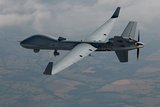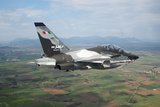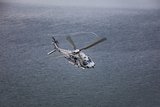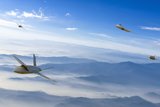New vision-based navigation integration offers protection to UAS
UAS fleets have increasingly been used on the front line meaning robust navigation is vital. (Photo: NATO)
ESEN has integrated its GöRDES vision-based navigation (VBN) system into the Pixhawk-ArduPilot autopilot system which allows Uncrewed Aerial Systems (UAS) to continue to function in a GNSS-denied environment.
The quest for navigation in GNSS-impoverished or jammed environments has been an ongoing defence technology challenge. In the UK, QinetiQ recently pledged £20 million (US$26 million) to building a new signal-resilience testing facility. In the US, systems such as AQNav have been using AI and machine learning to harness the Earth’s magnetic field as an alternative PNT source for when the GNSS signals – by far the most prevalent and primary source of navigation information for defence assets – go down through natural remoteness or through intentional jamming by enemy forces.
Alternative PNT for uncrewed systems will only become more important the more UAS, which are increasingly defeating legacy air defence systems designed to deal with larger aircraft, are deployed in combat situations.
Related Articles
QinetiQ to build silent hangar for UK to test GPS jamming resilience
The war in Ukraine and subsequent Ukrainian fightback have latterly depended strongly on drone stocks and operators capable of defying traditional anti-aircraft systems. Protecting the navigational integrity of UAS has, therefore, become a major concern for any force growing its fleet.
With the GöRDES integration, ArduPilot users have a UAS that will switch to VBN In GNSS-denied environments.
While in GNSS-rich environments, the VBN integration will act as a supporting or correcting source of navigational data, alongside the GNSS signals. That can be used as a guard against GNSS spoofing where the signal is essentially “stolen” by enemy forces and used to direct defence hardware to a location where it can be destroyed or commandeered.
The integration announcement came during the same week that the first Bayraktar TB2 UAS, built and operated in Turkey back in 2014, was retired from active duty and put out to pasture for training purposes. The S5 TB2 had accumulated more than 1 million flights hours across more than 750 sorties.
The two Turkish announcements bookend the first era of Turkish UAS building and development, each addressing a pressing need in UAS innovation in its own time.
More from Air Warfare
-
![Portugal signals interest in establishing A-29N final assembly line]()
Portugal signals interest in establishing A-29N final assembly line
As the launch customer for the NATO-configured variant, Portugal also took delivery of the first five A-29N aircraft from its order for 12, placed in 2024.
-
![Podcast: Critical Care episode 5 - Sustaining Europe’s frontline from Heidelberg]()
Podcast: Critical Care episode 5 - Sustaining Europe’s frontline from Heidelberg
As Europe ramps up defence investment in the wake of the Ukraine crisis, the spotlight is turning to how nations sustain their growing fleets.
-
![Leonardo signs contract on Austria’s M-346 aircraft order]()
Leonardo signs contract on Austria’s M-346 aircraft order
The first of the 12 M-346 aircraft are expected to be delivered to the Austrian Air Force by 2028, according to the company.
-
![German Navy in “ramp-up” phase as it welcomes first NH90 Sea Tiger delivery]()
German Navy in “ramp-up” phase as it welcomes first NH90 Sea Tiger delivery
With all 31 aircraft set to be delivered by 2030, the helicopters will gradually replace the ageing Sea Lynx fleet which are due to be retired in 2026.
-
![The future is here: Sixth-gen air dominance]()
The future is here: Sixth-gen air dominance
How RTX is equipping the military airspace – for today’s fleet and tomorrow’s fight.























